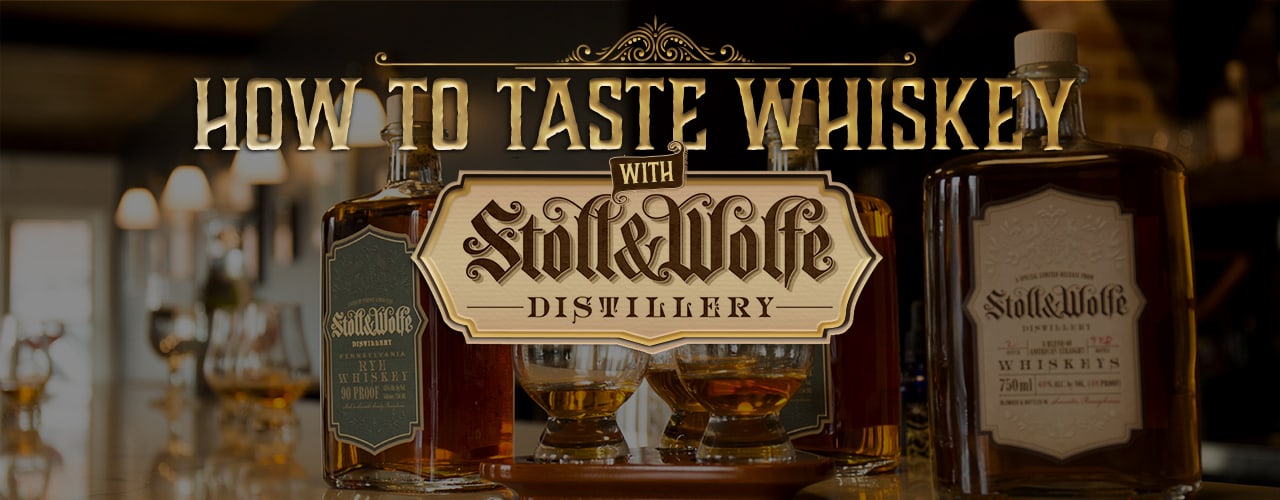
In recent years, many craft whiskey distilleries have popped up all over the United States, and there is increased interest in tasting whiskey among the population. As a result, many bars and distilleries are now offering whiskey tastings, which allow customers to sample a variety of whiskeys and compare the flavors. Due to the interest, it is a good idea for bar owners and bartenders to learn more about whiskey, the various flavors, and how to hold a whiskey tasting. To learn more about whiskey and share with you, we spoke with Lititz-based whiskey distillery, Stoll & Wolfe.
What Is a Whiskey Tasting?
A whiskey tasting is where you sample several different types of whiskey and compare and contrast their appearance, aroma, and taste. By tasting several different types of whiskey at once, you get a better understanding of each whiskey's unique characteristics.
There are two different ways that you can organize a whiskey tasting: horizontally and vertically. Horizontal whiskey tastings feature several different whiskeys that were created by the same distillery. Vertical whiskey tastings have whiskeys from different distillers that all share a common grouping or theme, such as several types of rye whiskey.
Sources of Flavor for Whiskey
To understand how to taste whiskey, you first need to understand where the flavors come from. There are four constants in the production of whiskey that affect the taste:
- Ingredients: The most important ingredient in whiskey that will affect the flavor of the beverage is the grain. Different types of whiskey, such as bourbon, scotch, and rye, are all made with different grains, which has an effect on the taste. Additionally, the growing conditions and location of the grain can also affect the flavor of the whiskey.
- Method of Production: Factors like how long the brew was fermented, the temperature it was fermented at, and the length of time can all impact the overall flavor of the whiskey.
- Aging: The age of the whiskey can also affect the flavor, as the whiskey will continue to interact with the wood in the barrel as it ages. Additionally, the type of cask you use and even the location of the barrel in the warehouse can affect the flavor.
- Filtration: Different methods of filtration and the number of times the whiskey is filtered can affect the flavor. Additionally, some distillers will blend different brews together or add unique amounts of water, which will affect the end result.
How to Serve Whiskey

Once you've decided which types of whiskey you're going to serve at your tasting, you need to serve them the correct way. Here is what you need to know to serve the perfect tasting of whiskey:
- Pour Size: The pour size will depend on the amount of whiskeys you're tasting, but between 1/2 and 1 ounce is a typically a good amount.
- Temperature: When you taste whiskey, it should be at room temperature. This means that you shouldn't taste whiskey on the rocks.
- Glassware: There are many different types of whiskey glasses to choose from, but Glencairn glasses are one of the best options for whiskey tasting because they have a chimney that helps funnel the aromas to your nose.
Should You Add Water to Your Whiskey?
Whether or not you should add water to your whiskey has been debated by whiskey aficionados for a very long time, and both sides make valid points. But, according to Erik Wolfe at Stoll & Wolfe, adding a one or two drops of water to your glass can unlock some of the hidden flavors in the drink. But, he also says that you should try to taste the whiskey without the water first.
How to Taste Whiskey

There are many ways that you can taste whiskey, depending on how you prefer it. But, Stoll & Wolfe has shared with us their secret to tasting whiskey and getting the most out of the experience. Here is how to properly taste whiskey:
1. Pour Your Glasses and Observe the Color
The first interaction with the whiskey is visual, which includes observing the color and clarity of the whiskey. When observing the color, you can make a note of how dark or pale the whiskey is. Additionally, you can look at the viscosity of the drink by swirling it around in your glass a few times. Some whiskeys are thicker, and they will cling on to the sides of the glass, while thinner whiskeys will run off.
2. Sniff the Aromas Coming from the Whiskey

Your nose can pick up many more flavors and aromas than your tongue can, so smelling the whiskey before you taste it can give you a better understanding of the flavor. When you smell, swirl the glass a few times to oxidize the alcohol and release some of the aroma. Additionally, you'll want to smell the glass at different distances from your nose, because the delicate aromas are lighter and you can detect them from farther away, while other notes are dense and stay closer to the rim of the glass.
The alcohol vapors in the whiskey can temporarily numb your nose over time, which makes it harder to smell. To counteract this, you can take a few deep breaths. Additionally, smelling the back of your hand or your arm can reset your nose and sense of smell.

3. Sip the Whiskey
Now we're finally ready to taste the actual whiskey. The flavor of the whiskey will evolve as you drink it, so Stoll & Wolfe suggests you split each tasting into three sips.
The first sip will have the burn from the alcohol, but you should begin to taste some of the flavors of the whiskey. On your second sip, try and think of the four primary flavors: sweetness, acidity, dryness, or saltiness, as well as any other flavors you may pick up. For your final sip, look for a structure to the whiskey and whether or not there is a distinct beginning, middle, and end to the flavor. If there is, think about if the three parts are balanced and if they complement each other.
4. Reset Your Palate
Whiskey is robust and full of flavor, so you should make sure and reset after tasting each type of whiskey with a sip or two of water. Additionally, if you need to reset your nose, you can try smelling yourself or taking a few deep breaths.
Because whiskey is becoming more popular with the general population, it's good for bar owners to learn more about whiskey, especially how to serve it properly. Additionally, holding whiskey tastings is an experience that many customers are looking for, which can be an excellent business opportunity. If you're looking for whiskeys to taste, check out whiskey from our friends at Stoll & Wolfe. You can also check out the video from our visit to Stoll & Wolfe below:





